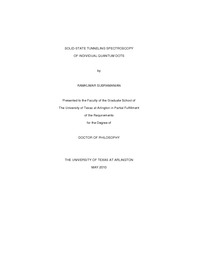
ATTENTION: The works hosted here are being migrated to a new repository that will consolidate resources, improve discoverability, and better show UTA's research impact on the global community. We will update authors as the migration progresses. Please see MavMatrix for more information.
Show simple item record
| dc.contributor.author | Subramanian, Ramkumar | en_US |
| dc.date.accessioned | 2010-07-19T19:54:55Z | |
| dc.date.available | 2010-07-19T19:54:55Z | |
| dc.date.issued | 2010-07-19 | |
| dc.date.submitted | January 2010 | en_US |
| dc.identifier.other | DISS-10661 | en_US |
| dc.identifier.uri | http://hdl.handle.net/10106/4931 | |
| dc.description.abstract | Quantum dots are gaining importance for their potential applications in the fields of energy harvesting, bio-labeling and treatment, in opto-electronic devices and in photonic devices. For all these applications, it is imperative to know their electronic structure. Although currently several spectroscopic techniques exist to study the electronic structure of these quantum dots, they are accompanied by other effects and do not give purely the electronic structure of the individual quantum dot. The main goals of this research are to:o To study the energy level structure of `single' quantum dots.o Develop a new spectroscopic technique that allows the measurement of the energy level structure of the single quantum dots.o Demonstrate that the tunneling spectroscopy can be carried out without other effects such as electron-phonon coupling, non-resonant tunneling, dielectric response of the capping organic layer etc. A major accomplishment from this research is the ability to study directly the energy level structure of individual quantum dots without peak broadening caused by other effects. Spectroscopic measurements were carried out using the double barrier tunnel junction (DBTJ) approach. The DBTJ is formed when a quantum dot placed on the periphery of the vertically separated source-dielectric-drain electrode structure. The measurement units were fabricated using CMOS compatible parallel batch processing techniques.Spectroscopic measurements were carried out using current-voltage and differential conductance measurements using the lock-in measurement technique. Using these measurements, the energy structure of individual quantum dots were mapped at room temperature as well as low temperatures. Conductance spectra showed that the peak-widths were linearly dependent only on the temperature and are not subject to any other broadening effects. The FWHM of the conductance peaks at 77, 150, 225 and 295K were measured to be 3, 7, 9 and 18meV respectively. The peak widths from this study are narrower when compared to ~60meV from STM spectroscopy conducted on 6.1nm CdSe quantum dots even at ~5K. Due to the dependence of the peak width only on the temperature, fine energy level separation measurements are possible using this spectroscopic technique. This narrow peak width allows the measurement of the electronic structure even at room temperature. | en_US |
| dc.description.sponsorship | Koh, Seong Jin | en_US |
| dc.language.iso | EN | en_US |
| dc.publisher | Materials Science & Engineering | en_US |
| dc.title | Solid-state Tunneling Spectroscopy Of Individual Quantum Dots | en_US |
| dc.type | Ph.D. | en_US |
| dc.contributor.committeeChair | Koh, Seong Jin | en_US |
| dc.degree.department | Materials Science & Engineering | en_US |
| dc.degree.discipline | Materials Science & Engineering | en_US |
| dc.degree.grantor | University of Texas at Arlington | en_US |
| dc.degree.level | doctoral | en_US |
| dc.degree.name | Ph.D. | en_US |
| dc.identifier.externalLink | https://www.uta.edu/ra/real/editprofile.php?onlyview=1&pid=254 | |
| dc.identifier.externalLinkDescription | Link to Research Profiles | |
Files in this item
- Name:
- Subramanian_uta_2502D_10661.pdf
- Size:
- 33.41Mb
- Format:
- PDF
This item appears in the following Collection(s)
Show simple item record


